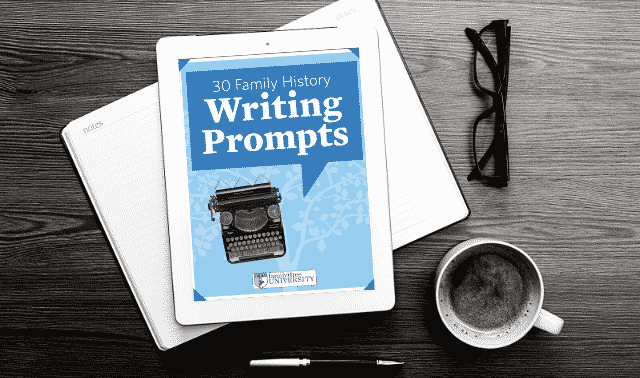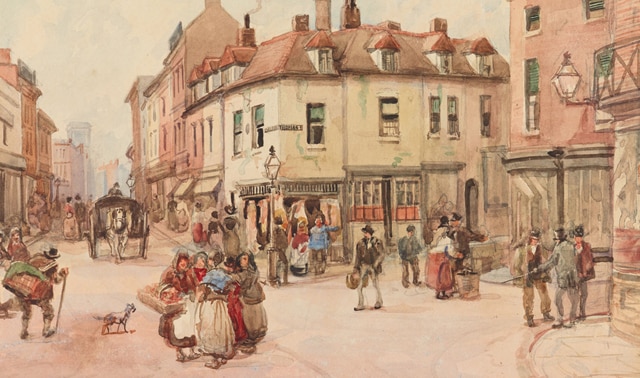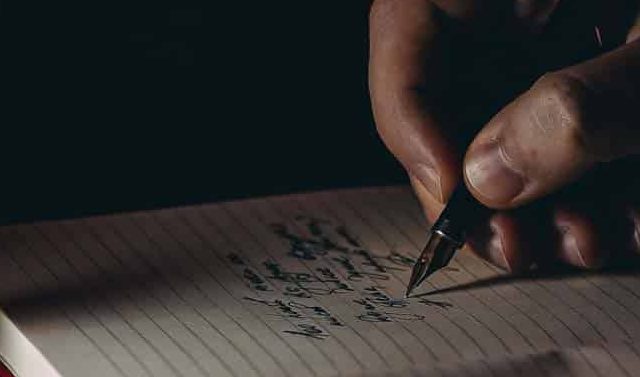
Investigating the bygone world of your ancestors, immersing yourself in the details of yesteryear, and maybe even capturing ancestors’ lives in a narrative family history — such sojourns into the past make a fascinating hobby. But for authors who write about history, making yesterday as vivid and engaging as today isn’t just a sideline: It’s their job.
If a biography or a book about a turning point in history contains little more than page after page of names and dates — the historian’s equivalent of pedigree charts — readers won’t make it past the first chapter. Famous figures and epochal battles may provide essential skeletons to the story, but the professional historian’s job is to put flesh on those factual bones and bring past events and characters to life. That requires not only literary skills but also detailed research.
If you’re thinking of writing your family’s history, obviously you can learn a thing or two from folks who research and expound upon history for a living. But even if your ambitions go no further than wanting to see what life was like and walk a mile in your ancestors’ shoes, these research tricks of the history writer’s trade can make your efforts more rewarding.
1. Be a History Reporter
Of course, delving into the world of your ancestors is easier if Great-grandpa happens to be famous. When Ron Powers, a Pulitzer Prize-winning newspaper writer and Emmy Award-winning TV correspondent-turned-biographer, set out to write Mark Twain: A Life (Free Press), he could tap some 12,000 annotated letters in the Mark Twain Papers archive at the University of California, Berkeley. But Powers also had to research 19th-century life in locations from Twain’s hometown of Hannibal, Mo., to Nevada to Boston. His mining for details enabled him to set scenes the way a novelist might, as in this evocative opening:
On a chilly mid-November evening in 1869, a small man with a deranged mop of curly red hair and a wide-swept red mustache sauntered among the pedestrians in the 100 block of Tremont Street in Boston. He was desperately out of place amid these men in their muttonchops and tailored Scottish tweeds, and these women in their jeweled bonnets and brilliant brocade-lined shawls.
“You really have to cast your net wide and become a reporter, just like those reporters you’ve seen in the movies,” says Powers. He cites the example of a book he co-authored with James Bradley, Flags of Our Fathers (Bantam). It’s the story of the men who raised the American flag on Iwo Jima (which Clint Eastwood made into a movie). “James spent three years on the phone, rounding up and tracking down the men who were still living and those who’d known them. That’s what brought Flags to life.”
You don’t have to spend years on the phone, but do talk to your relatives about their experiences and the places they grew up. Look for others’ oral histories recorded or transcribed at websites such as the Library of Congress’ (LOC) Veterans History Project and slave narratives collection, and Rutgers University’s Oral History Archives. Search the online National Union Catalog of Manuscript Collections for libraries with historical manuscript collections relating to an ancestor’s social club, employer, religion or ethnicity.
For his book White Town Drowsing (Anchor Press) — about Hannibal as it prepared to celebrate the sesquicentennial of Twain’s birth — Powers used sources such as annual city directories (usually available at libraries for the surrounding area) to re-create the world of his own boyhood and his parents’ early years there. “The directories were incredibly evocative,” Powers says. “I found that my mother had been a heel trimmer at a shoe store, something she’d never brought up. I found all my father’s addresses, the rooming houses where he lived when he rolled into town in his Model A Ford from southern Illinois to sell Fuller brushes.”
2. Mine Big Books and Diaries
Whatever era you’re investigating, there’s likely a single big text you can start with for an overview of the time and place. William Martin, the best-selling author of mysteries that intertwine past and present, such as The Lost Constitution (Forge), says he starts his research there. Even though Martin writes fiction, his novels must be solidly grounded in historical fact and richly detailed to re-create the times.
So for Cape Cod (Grand Central), Martin turned first to Samuel Eliot Morison’s The Story of Old Colony of New Plymouth, 1620-1692 (Random House), a classic history published in 1952. “Then I’ll follow back to the sources that author recommends,” Martin says. “Eventually, I’ll narrow again to primary sources.”
Search online or ask a history librarian for reading recommendations. Besides standard histories, don’t overlook published diaries for getting grounded in the past, says H.W. Brands, a Pulitzer Prize nominee for his biography of Benjamin Franklin, The First American (Anchor). “Many times and places have their signature diarists. For London in the 1660s, you’d read Samuel Pepys. For 19th-century New York, Philip Hone kept a diary for 40 years, or you could also read the diary of George Templeton Strong.”
Your ancestors — or at least their peers — also might’ve left diaries, letters and other papers. For his book on the California Gold Rush, The Age of Gold (Anchor), Brands explored the lives of everyday people in the archives of that massive westward movement at the Huntington Library, the California State Library and Berkeley’s Bancroft Library. Such sources are well-indexed, so you can check in advance — using online finding aids, by phone or by mail — to see if an ancestor is mentioned. Even if your particular ancestor isn’t represented, you can follow the saga of people who migrated from the same area.
Ask relatives if they know of any diarists in the family, and look for journals at historical society libraries. To find published journals from your ancestor’s era or locale, consult American Diaries: An Annotated Bibliography of Published American Diaries and Journals (Gale Group).
3. Read the Papers
Libraries are a treasure trove of old newspapers, and even if your local library doesn’t have those you need, you usually can borrow them on microfilm through interlibrary loan. Brands says he usually starts by checking the LOC’s Chronicling America online newspaper directory to see what publications and editions are available, and which libraries hold them.
“More and more 19th-century newspapers are being digitized, especially those from small towns,” he adds. For big-city publications, such as The New York Times or The Washington Post, Brands suggests using the ProQuest’s Historical Newspaper Collection, available free through many libraries.
Even if you can’t find a newspaper from your ancestor’s hometown, you can get a feel for Great-great-grandpa’s daily life by perusing publications from towns of similar size in the same general region.
“Advertisements are the first thing I look at in old newspapers,” Brands says. “By the late 19th century, advertisements started to have illustrations, so you might see satisfied customers of Pear Soap or Dr. Johnson’s Patent Medicine. Classified ads began very early, so you may see the town cobbler is having a sale on boots this month. Ads give you a glimpse into daily life — what people thought about when they got up in the morning.”
Look at the cost of products, Brands advises, and try to get a sense of “the necessities of civilized life” for a certain economic class in a given era. Even rich people didn’t have flush toilets or water heaters in the early 20th century, he points out. “It simply didn’t occur to people. Later, in the late 1920s and ’30s, the radio became a fixture of middle-class life; you’d have a big radio in the middle of the living room, parlor or kitchen.”
“So much of people’s history is embodied in old newspapers,” Powers adds. “You can find the contextual information for your history — the price of a dress, what was playing at the Orpheum, sports.”
Go beyond reading the words in old periodicals, Martin continues — study the engraved illustrations and, in later years, the photographs. If you’re trying to imagine the life of a Civil War ancestor, for example, look at the images in the LOC’s Civil War collection: “Why did so many soldiers die from ‘camp fever’ in the winter of 1862? Look at the mud, the latrines, the flimsy tents, and you can see how hard and miserable it was, why two-thirds of the casualties in the Civil War were not on the battlefield.”
“Don’t just glance at a photo,” Martin adds. “Study it. Absorb all the nuances and detail.” He picks up a photo of the blacksmith shop run by his wife’s grandfather as an example: “He was a German immigrant, and here he looks pretty proud of having built a substantial business. His two apprentices looked pretty pleased to be working there, too. You can see who he was and what he took pride in.” Uncovering Your Past Through Family Photographs, 2nd edition, by Maureen A. Taylor (Family Tree Books) has tips for finding and interpreting old photographs.
4. Step into the Past
Armchair research and library books can take you only so far into your ancestor’s world. “One of the first things I do to get a sense of the surroundings and physical reality is to visit the place,” Martin says. “When I wrote about George Washington, I went every place Washington went. I not only walked the battlefields, I spent time in his rooms at Cambridge. I saw the sunlight Washington would have seen coming through the windows, and that beam of light became my time machine.”
If you don’t know exactly where an ancestor lived, or the places are long gone, visit similar historical locations and recreations. “If you know an ancestor came over on the Mayflower, you should go to Plimouth Plantation, where they have re-enactors playing the roles,” Martin says. “When I was researching Cape Cod, I haunted that place for days on end. You can see how they cooked, what foods they ate, and see the surroundings in three dimensions. Taste the Indian pudding, the gingerbread and molasses. No matter where you live or your ancestors lived,” Martin says, “there are historical sites, threads of history running through the environment.”
Brands agrees. “Historical museums are all over the place. You can see the artifacts of daily life, clothes like those your ancestor wore. Look at the shoes: People’s feet were much smaller in the 19th century.”
The Museums USA website allows you to search for potential destinations by category, or by state; for ideas on living history museums to visit, see this list on Wikipedia. To really get to know your ancestor, follow Brands’ suggestion to mentally reproduce a typical day from the time your relative woke up to the time he went to bed. “If the person was a field worker, did he get a break for lunch? How long did he work? What clothes did he wear?”
Following in your ancestor’s footsteps can pay dividends beyond the historical. When Powers was researching White Town Drowsing, he walked around the town of Hannibal and actually met people who remembered his father and could relate stories about him. “It’s a town of steep hills, and the brakes on my dad’s Ford weren’t good, so it was tough to get downhill. I found a man who saw my dad, all dressed up to sell his Fuller brushes, begging, ‘I’ll give you anything to get me off this hill!’ He had to bump his way down the hill, hitting trees and other objects to slow him down.”
“A side effect of this research,” Powers adds, “is that for the first time in my life I had to look at my father not as my dad but as a figure in the town. I softened toward him for the first time in my life. They’re not just your parents or grandparents when you see them in the light of other people. They become plausible, understandable, demystified.”
He pauses, thinking of what he learned about his father in Hannibal. “I got to know him better,” Powers says. “It made him a guy.”
5. Cast a “Wide Net”
Professional historians have learned to cast a “wide net,” as Powers puts it. Among the other resources they recommend you consult:
- The Internet, of course, is becoming an ever-more-valuable tool. “It’s really idiosyncratic what you’ll find,” Brands says. “Try fiddling around with keywords to get just the right search.”
- Don’t overlook the possibility that your ancestor wound up in someone’s scrapbook, or kept one himself, Powers suggests. It’s amazing how many people kept scrapbooks, and if their lives and that of an ancestor intersected. Ask your relatives if they know of a scrapbook, and keep an eye out at the local historical society library.
- Even small towns often have historical societies, Brands points out. “They publish newsletters and journals from which you can get a sense of the texture of daily life.”
- Similarly, many towns and counties published exhaustive local histories, which you can find in library collections or even on websites such as HeritageQuest Online (free through subscribing libraries). “These cover mundane material, but they’re all the more valuable for it,” says Brands. “It’s not just the big-picture stuff, but who the May Queen was.”
- Civil War-era researchers should of course turn to regimental histories, Martin says. “These track where they went, what battles they fought. In the back, most list the fates of all the foot soldiers in the unit.”
- Take advantage of reference librarians’ skills and enthusiasm. “They’re an invaluable resource,” Brands says. “They’ve become experts at information systems and science.”
Related Reads
A version of this article was posted online in July 2008. Last updated: November 2024











